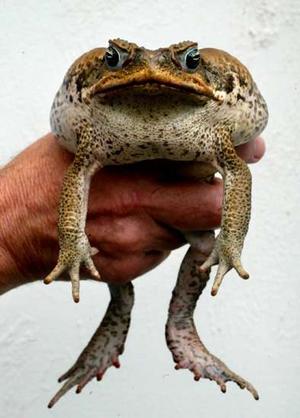

Get your Stop The Toad
bumper sticker here ..

Web Masters:
Use this button to
link back to this site.

Toad MediaMEDIA RELEASE - THE AGEJune 2, 2006 - 8:47AMWar on cane toads Government television ads warn ominously of the looming "invasion", and urge all West Australians to join the fight. A government website describes efforts at the "frontline", about 170km east of the Northern Territory border, to keep the scourge at bay. It talks of surveillance teams and night-time incursions into enemy territory, and of scientific efforts to develop a "biological control" to wipe out the toxic and resilient attackers. The enemy? Cane toads. Just 102 cane toads were introduced to northern Queensland in the 1930s to help control the native cane beetle, which was devastating sugar cane crops. Seventy years later, hundreds of thousands of the poisonous beasts have spread across Queensland, the NT and northern New South Wales, decimating native wildlife and ecosystems. And now they're knocking on WA's door. They pose a major threat to flora and fauna, and the unique and fragile northern Kimberley region will bear the brunt of a WA toad onslaught. They're voracious eaters, outperforming a wide range of native animals in the hunt for food, and they're so poisonous they have no natural predators to keep their numbers down. The toads have had a devastating effect in the NT, with large numbers of quolls, snakes, lizards and even crocodiles dying after eating them. And they breed easily: a female cane toad can lay up to 70,000 eggs every year. Ecologists warn that, unless stopped, the noxious critters will eventually colonise Perth and may even infest areas as far south as Margaret River and Esperance. WA has historically gone to great lengths to keep out ecological pests. The Rabbit Proof Fence, which stretches 1,837km from Starvation Harbour in the south to Cape Keraudren in the north, is perhaps the most famous example. In his seminal memoir The Shark Net, writer Robert Drewe describes WA's Great Sparrow Panic of the 1950s, when government "Sparrow Rangers" stalked the streets with shotguns to eliminate the diminutive birds. "The ants and sparrows were like fruit flies, Ceylon crows and 'conmen' from the Eastern States ... All of them had the potential to make our lives a little less harmonious," Drewe wrote. In 1971, WA authorities introduced a similar campaign to wipe out starlings, and they've killed about 60,000 of the birds since. But the war against cane toads promises to be the biggest and most difficult battle WA has yet waged against alien invaders. Dennis Beros, who runs the Perth-based campaign group "Stop The Toad", says it will not be an easy fight. "It's a hell of an ambitious thing to try and even have a go at this," Mr Beros said. "The only thing that's going to stop it is a really profound cooperation between government agencies, community groups and corporates, people who can bring money and resources into this." WA has taken a proactive stance to stop the cane toad reaching the border. In addition to the $500,000 state government toad awareness campaign, over television, radio, newspapers and the internet, WA has tightened quarantine controls and put money into toad research. State Environment Minister Mark McGowan says the government is spending $2.5 million to fight the advance of "these awful biological creatures". Local communities have also taken up the offensive. In the Kimberley town of Kununurra, a local environmental group, dubbed Toad Busters, is regularly taking the fight over the nearby NT border, trapping, monitoring and killing toads. But Mr Beros says all these efforts, while necessary and admirable, have thus far failed to contain the threat. "They clearly have not worked brilliantly so far," he said. "We need to have a major on-ground strategy that needs to come in this next dry season, we need a major dry season offensive." Even then, Mr Beros said, the real war is being fought in the laboratory. "There is a likelihood that we'll find some kind of silver bullet, a biological or other type of control, hopefully in the next couple of years, to really deliver the king hit," he said. "So basically the view is that all these other measures are just holding back the tide, and that's important." "It's a war and it has to be fought on multiple fronts." AAP
|
Supported by |
 |
Web Manager: Dave Graham - Web hosting & scripts: Alex Varlakov http://ozup.com/ |


 Western
Australia is preparing for war.
Western
Australia is preparing for war.
















